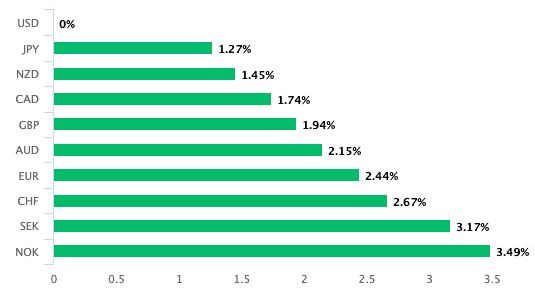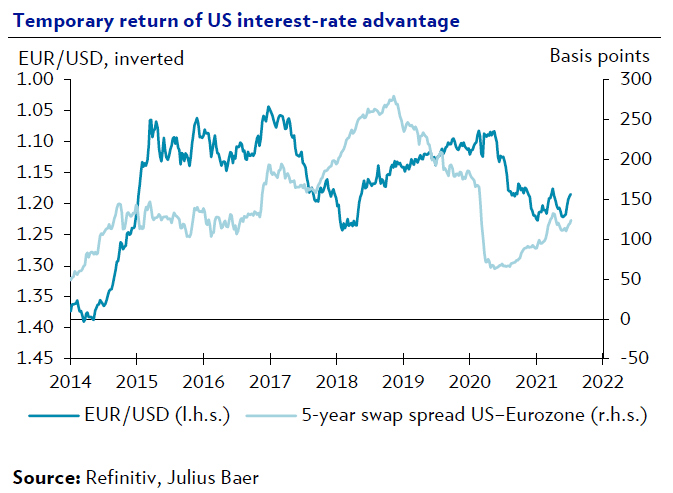Pound-to-Dollar Outlook: USD Strength Temporary says Julius Baer
- Written by: Gary Howes
-
"Headwinds will intensify going into next year. We stick to our longterm Bearish USD outlook" - Julius Baer.

Image © Adobe Images
- GBP/USD reference rates at publication:
- Spot: 1.3860
- Bank transfers (indicative guide): 1.3474-1.3570
- Money transfer specialist rates (indicative): 1.3730-1.3760
- More information on securing specialist rates, here
- Set up an exchange rate alert, here
The strong performance of the U.S. Dollar through the mid-year period has caught many in the foreign exchange market by surprise, but currency analysts at a leading Swiss bank are sticking with their view that the Dollar will underperform longer-term.
In a mid-year currency review, Julius Baer researchers say while further pockets of U.S. Dollar strength may be a feature of the next months as the 'tapering' debate at the U.S. Federal Reserve intensifies, "we stick to our long-term Bearish view."
Such expectations, if correct, will likely keep the Pound-to-Dollar exchange rate (GBP/USD) on a longer-term uptrend.
The call comes as the Dollar was seen to be the strongest performing currency in June with the rebound sending the GBP/USD exchange rate back below the 1.40 level.

Above: Dollar outperformance over the course of the past month.
Secure a retail exchange rate that is between 3-5% stronger than offered by leading banks, learn more.
Dollar strength came as the U.S. Federal Reserve's (Fed) policy makers brought forward the date at which they expected interest rates to rise in the U.S. from 2024 to 2023 at their June policy meeting.
Pressure is meanwhile growing on the Fed to set out how it intends to end its quantitative easing programme (tapering), a necessary precursor to any interest rate rise.
The shift in expectations for the future of Fed policy have pushed the yield paid on U.S. government bonds higher, which in turn creates demand for the Dollar.
Underlying the Fed's shifting stance is the strong U.S. economy, which is now printing inflation data well above the Fed's 2.0% target level.
But Julius Baer's economists are sanguine about the spike in U.S. inflation of late, saying it remains "harmless".
They say U.S. inflation has been massively distorted by transitory effects and will therefore likely settle back at lower levels, easing pressure on the Fed to rush into a rate hike.
{wbamp-hide start}
{wbamp-hide end}{wbamp-show start}{wbamp-show end}
"We expect US inflation readings to decline from here and become a red herring in the second half of 2021," says Julius Baer economist Julius Kohl.
Indeed, the transitory nature of the inflation spike will allow the Fed to focus on the employment situation, which will take many months to return to pre-pandemic levels.
"The Fed’s goal of maximum employment is still far away, allowing it to stick to a loose monetary policy stance despite strong growth and a sharp inflation increase," says Kohl.
Julius Baer foreign exchange analyst David Alexander Meier says his team are minded to stick to a bearish long-term USD outlook as a result.
Recent Dollar strength has been driven by rising U.S. bond yields, described by Meier as an interest rate advantage:
"Going forward, the launch of the tapering debate in August or September may lead to further pockets of temporary dollar strength," he says.
But experience suggests to Meier that the USD is more sensitive to shifts in rate hike expectations as opposed to any tapering of asset purchases alone.
Tapering discussions at the Fed due later in the year are therefore unlikely to prove a lasting source of support for the Dollar, in his view.
Furthermore, the U.S. economy's exceptional levels of growth - fuelled by stimulus - are likely to fade into 2022.
"We stick to our view that the dwindling US fiscal support – as coronavirus aid will not be repeated – will lead to significantly weaker US GDP growth in 2022," says Meier.
Another factor behind the soft Dollar thesis at Julius Baer include corporate tax hikes in the U.S., required to finance the Biden administration’s Americas Families Plan.
"We hold on to our view that current monetary policy-related tailwinds may support the USD in the short term, but that headwinds will intensify going into next year. We stick to our longterm Bearish USD outlook," says Meier.
Where the U.S. Dollar goes from here is however a subject of fierce debate in foreign exchange circles with a number of analysts saying the shift at the Fed marks a watershed moment.
"Dollar bears, surfing a wave of easy Fed policy, are running out of time. If the US can escape the clutches of the zero-rate bound, it will earn itself a significantly stronger dollar," says Kit Juckes, Macro Strategist at Société Générale.
Juckes says if U.S. data remain strong, inflation doesn’t fall back quickly and other markets don’t react so violently as to give the Fed serious pause for thought, it’s hard to see why the Fed shouldn’t move ahead with tapering, while continuing the debate about when to start the rate-hiking cycle.
"If that happens, the dollar has likely already passed its lows for this cycle," he adds.






